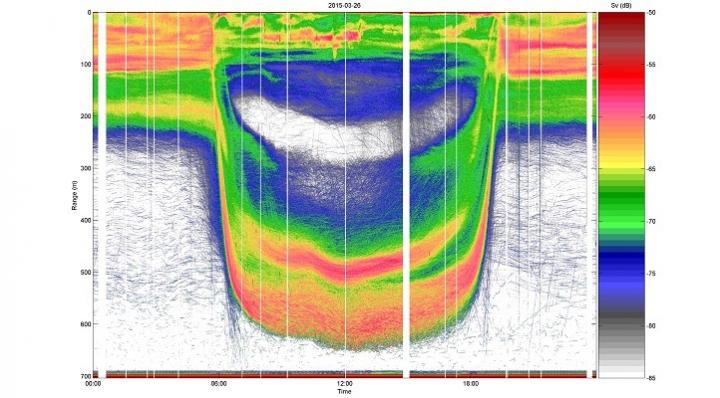Novel carbon source sustains deep-sea microorganism communities

This echogram section displays the acoustic data showing the vertical and temporal distribution of fish within a 24-hour cycle. Contouring represents the presence (orange) and absence (white) of fish within the water column. Fish are retreating to 400 and 600 meters depth during the day and spending time in the upper 200 meters at night. The almost vertical lines show the fish swimming down at sunrise and up at sunset. Credit: © 2018 KAUST
The biological carbon pump is a cyclical process by which inorganic carbon from the atmosphere is fixed by marine lifeforms and transported through ocean layers into the deepest waters and ocean sediments. Fish that feed at the surface at night and retreat to the mesopelagic zone (200 to 1000 meters depth) by day were thought to influence carbon cycling, but the extent of their contribution has never been explored.
Now, Maria Calleja and Xosé Anxelu Morán at KAUST's Red Sea Research Center, and coworkers, demonstrate the impact of this daily migration on the vertical movement of carbon in the Red Sea and how it fuels the metabolism of single-celled heterotrophic prokaryotes belonging to the domains Bacteria and Archaea.
“In a previous study, our co-authors Anders Røstad and Stein Kaartvedt discovered a community of fish in the Red Sea that migrate every night from around 550 meters depth to the surface waters to feed1,” says Calleja. “We wondered how this fish migration might affect the microbial community inhabiting the same depths. Our two projects sought to clarify this by collecting data from a single Red Sea sampling site.”
The first study examined vertical differences in DOC concentration and the flow of carbon through microbial communities at three specific layers in the water column during the day1. Over eight days, the team monitored features such as DOC consumption, prokaryote growth and community composition in natural water samples taken from the surface, the deep layer where the fish rested during the day, and an intermediate layer at 275 meters.
Bacterial growth efficiency in the deepest layer was significantly higher than previously estimated, “suggesting a labile DOC source–one that is tasty and easily broken down by the bacteria–that helps generate larger cells,” explains Calleja. Heterotrophic bacterial communities in the mesopelagic layer were also found to be more active than those in the surface waters.
“Our second paper, led by a former KAUST post-doc who is now at the University of Exeter, Francisca García, followed changes over 24 hours along the whole water column, sampling 12 different depths (from 5 to 700 meters) every two hours2,” says Calleja. “We analyzed the dynamics between DOC, bacteria and fish movements during the 24-hour cycle.”
The researchers used flow cytometry to analyze microbe cell sizes and community structure at high temporal resolution, showing higher microbial diversity in the mesopelagic zone than expected. These deep microbial communities may be more dynamic than previously thought, thanks to this active carbon transfer of labile DOC by fish.
“If this is happening in the Red Sea, could it be happening in other marine basins and the open ocean? It may have unprecedented implications for the global ocean carbon cycle,” notes Calleja.
“These two studies are part of a wider project to determine the impact of this shortcut on global biogeochemical cycling,” adds Morán.
Media Contact
All latest news from the category: Life Sciences and Chemistry
Articles and reports from the Life Sciences and chemistry area deal with applied and basic research into modern biology, chemistry and human medicine.
Valuable information can be found on a range of life sciences fields including bacteriology, biochemistry, bionics, bioinformatics, biophysics, biotechnology, genetics, geobotany, human biology, marine biology, microbiology, molecular biology, cellular biology, zoology, bioinorganic chemistry, microchemistry and environmental chemistry.
Newest articles

Sea slugs inspire highly stretchable biomedical sensor
USC Viterbi School of Engineering researcher Hangbo Zhao presents findings on highly stretchable and customizable microneedles for application in fields including neuroscience, tissue engineering, and wearable bioelectronics. The revolution in…

Twisting and binding matter waves with photons in a cavity
Precisely measuring the energy states of individual atoms has been a historical challenge for physicists due to atomic recoil. When an atom interacts with a photon, the atom “recoils” in…

Nanotubes, nanoparticles, and antibodies detect tiny amounts of fentanyl
New sensor is six orders of magnitude more sensitive than the next best thing. A research team at Pitt led by Alexander Star, a chemistry professor in the Kenneth P. Dietrich…





















